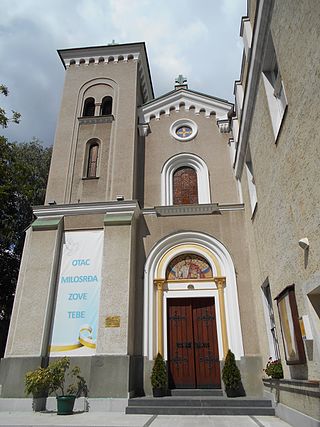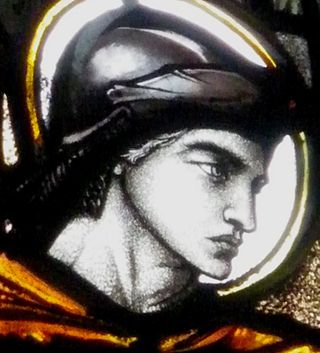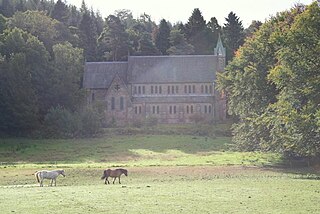
Saint Thomas Church is an Episcopal parish church of the Episcopal Diocese of New York at 53rd Street and Fifth Avenue in Midtown Manhattan, New York City. Also known as Saint Thomas Church Fifth Avenue or Saint Thomas Church in the City of New York, the parish was incorporated on January 9, 1824. The current structure, the congregation's fourth church, was designed by the architects Ralph Adams Cram and Bertram Grosvenor Goodhue in the French High Gothic Revival style and completed in 1914. In 2021, it reported 2,852 members, average in-person attendance of 224 and $1,152,588 in plate and pledge income.

The Church of Saint Bridget is in Bagot Street, Wavertree, Liverpool, Merseyside, England. It is recorded in the National Heritage List for England as a designated Grade II* listed building, and is an active Anglican parish church in the diocese of Liverpool, the archdeaconry of Liverpool and the deanery of Toxteth and Wavertree.

Gabriel Loire was a French stained glass artist of the twentieth century whose extensive works, portraying various persons or historical scenes, appear in many venues around the world. He founded the Loire Studio in Chartres, France which continues to produce stained glass windows. Loire was a leader in the modern use of "slab glass", which is much thicker and stronger than the stained glass technique of the Middle Ages. The figures in his windows are mostly Impressionistic in style.

St Ambrose Church, in Widnes, England, was built in 1882 to a design by James Francis Doyle of Liverpool.

St. Luke's and St. Margaret's Church is a former parish of the Episcopal Diocese of Massachusetts in the Allston neighborhood of Boston. It was closed in 2010.

St Cyprian's Church, Hay Mills is a parish church of the Church of England in Hay Mills, Birmingham, England. It is situated on the southern side of the main Birmingham to Coventry Road A45 at the end of a lane called the Fordrough that leads to the factory of Webster & Horsfall Ltd. It has long been associated with the Horsfall family who built the church and continue to be its owners. Built in the 19th century of red brick in the Gothic Revival style it is dedicated to St Cyprian the third century martyr and Bishop of Carthage who although coming from a wealthy background gave away a portion of his wealth to the poor of Carthage, he was beheaded by the Romans in 258. The church is now Grade II listed.

St Deiniol's Church, Hawarden, is in the village of Hawarden, Flintshire, Wales. It is the parish church of the rectorial benefice of Hawarden in the deanery of Hawarden, the archdeaconry of Wrexham, and the diocese of St Asaph. The church has associations with W. E. Gladstone and his family, and is designated by Cadw as a Grade II* listed building.

St Stephen's Church is a redundant Anglican church in the village of Copley, West Yorkshire, England. It is recorded in the National Heritage List for England as a designated Grade II* listed building, and is under the care of the Churches Conservation Trust.
Cox & Barnard Ltd was a stained glass designer and manufacturer based in Hove, part of the English city of Brighton and Hove. The company was founded in Hove in 1919 and specialised in stained glass for churches and decorative glass products. Many commissions came from Anglican and Roman Catholic churches in the English counties of East Sussex, West Sussex and Kent. The company was also responsible for six war memorial windows at an Anglican church in Canada, made from shards of glass collected from war-damaged church windows across Europe.

The Co-cathedral of Christ the King is a Catholic place of worship located in Krunska 23, in the city center of Belgrade, Serbia. It is the oldest extant Catholic church in the city south of the Sava and the Danube rivers, and was built between 1924 and 1988, the cathedral of the Archdiocese of Belgrade.

Margaret Isobel Chilton (1875–1963), born at Clifton, Bristol, was a British stained glass artist and instructor.

St Margaret's Church is in Lonsdale Road, Halliwell, Bolton, Greater Manchester, England. It is an active Anglican parish church in the deanery of Bolton, the archdeaconry of Bolton, and the diocese of Manchester. Its benefice is united with that of Christ Church, Heaton.
Lilian Josephine Pocock (1883–1974) was a stained glass artist who provided stained glass for a number of buildings, including Ulverston Victoria High School, The King's School and Ely Cathedral. She was also a theatrical costume designer, book illustrator and watercolourist. In her later years, failing eyesight prevented her from continuing her work in stained glass. After some years of retirement she died in 1974.

Rachel de Montmorency, née Rachel Marion Tancock, was an English painter and artist working in stained glass. She learned about stained glass when she worked for artist Christopher Whall in the 1910s and 1920s. During World War I she worked as a voluntary nurse.

The Church of Holy Trinity and St George is in New Road, Kendal, Cumbria, England. It is an active Roman Catholic parish church in the diocese of Lancaster. It is recorded in the National Heritage List for England as a designated Grade II* listed building. The church was founded by the parish priest, Thomas Wilkinson, and designed by local architect George Webster. Architectural historians regard the church as the best of the three designed by Webster in the town.
Stephen Adam (1848–1910) was a 19th/20th-century Scottish influential stained glass designer. He was a pioneer of modern stained glass in Scotland. The majority of his work is in the Pre-Raphaelite style, often with a twist towards Celtic mythology, and is mainly sited in western Scotland. Although the bulk of his work is for churches he also received many secular commissions.

St Margaret's Church is a church of the Scottish Episcopal Church near Aberlour in Moray, Scotland. It is Gothic in style, built mostly of tooled granite rubble, and has a cruciform layout with an east–west oriented nave, transepts to the north and south, and a slender tower at the south-west corner. Its interior is lavishly decorated with polished granite columns topped with ornately carved capitals, marble chancel furniture, and many stained glass windows depicting saints and biblical scenes.
Alfred Alexander Webster (1883-1915) was a Scottish stained glass artist in the early nineteenth century. His talent established him as the successor to the Glasgow stained glass designer Stephen Adam who in turn considered Daniel Cottier to be his master. Webster was considered one of the most accomplished artists working in stained-glass during this period. Websters Theatre, Glasgow on 416 Great Western Road, Glasgow is named after Webster as the building contains two major stained glass windows designed by him.















